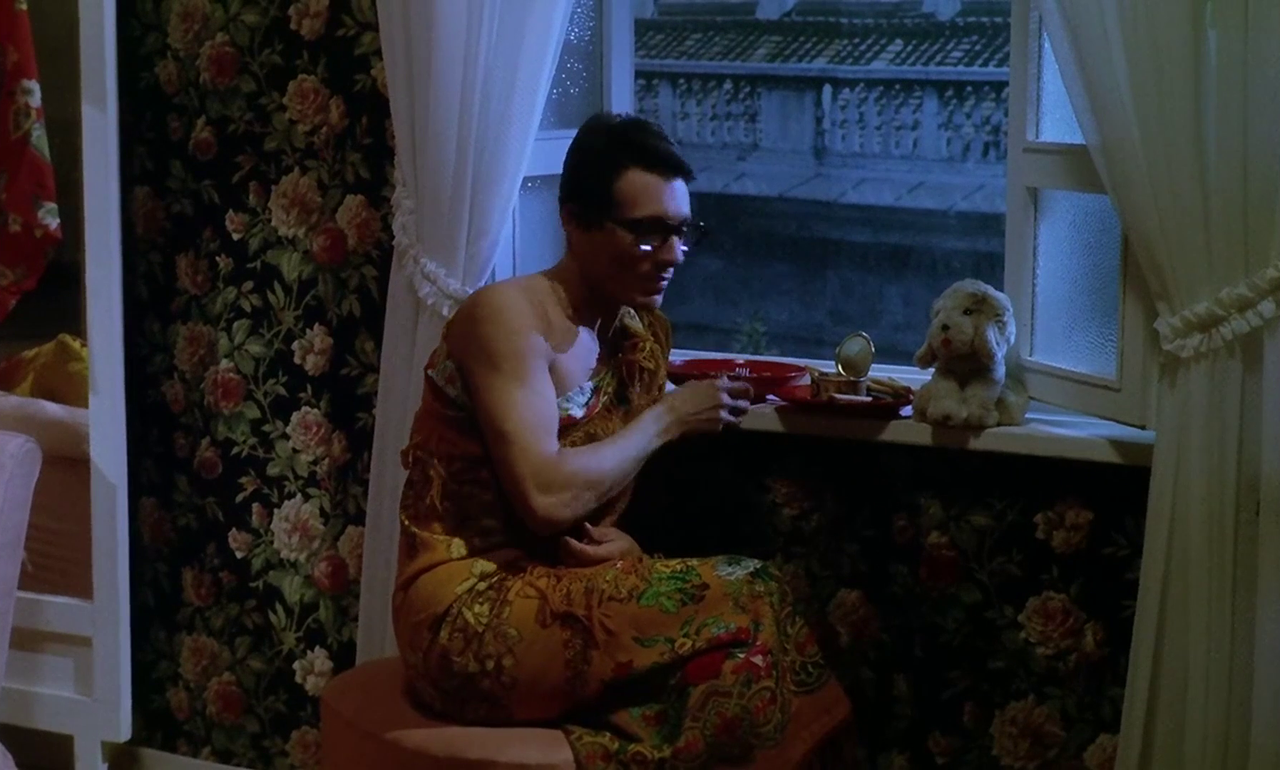“The madwoman has received your grace.”L'amore (Roberto Rossellini, 1948)
Apr
22
alms

Nannina (Anna Magnani) in “Il miracolo”, ascending a staircase while eating her alms. DP of this segment: Aldo Tonti; DPs “Una voce umana”: Robert Juillard & Otello Martelli.
– Nannina
religion
Salesman (Albert + David Maysles, Charlotte Zwerin, 1969)
Mar
29
breakfast

Bible salesmen enjoying breakfast at a soulless motel. DP: Albert Maysles.
Watched on Good Friday.
“Let's be different. Let's not hate anyone.”The World's Greatest Sinner (Timothy Carey, 1962)
Mar
1
eggs

Clarence “God” Hilliard (Timothy Carey) sitting at a round dinner table talking to his wife who's leaning against a counter holding a carton of eggs and crockery. DPs: Frank Grande, Robert Shelfow, Ray Dennis Steckler & Edgar G. Ulmer.
– Clarence “God” Hilliard
Иконостасът [Ikonostasat / The Icon Stand] (Christo Christov + Todor Dinov, 1969)
Feb
5
apples

A closeup of woman's hand moving an apple. The black-and-white photography is deliberately out of focus. DP: Atanas Tasev.
L'udienza [The Audience] (Marco Ferreri, 1972)
Nov
14

Amedeo (Enzo Jannacci), a young man with heavy rimmed glasses wrapped in heavy, flowery drapes as if it's a toga, eating late at night. There's an opened can on one of his plates. A sad looking stuffed toy dog hangs out. DP: Mario Vulpiani.
“If one can't be saint, it's better to be damned.”Matka Joanna od Aniolów [Mother Joan of the Angels] (Jerzy Kawalerowicz, 1961)
Nov
9
Chaos Never Dies Day

A possessed nun in white spinning on her axis among her sisters. Black clad priests in the background observe the scene. DP: Jerzy Wójcik.
Four years after the tragic events at Loudun. Mother superior, the titular Mother Joan, is still possessed by the Devil and has slowly pulled in the other sisters. A priest, the fourth one, is send to the convent to exorcise the demons who at this point have possessed all but one sister. Chaos ensues.
– Mother Joan of the Angels
Ostia [A Violent Life] (Sergio Citti, 1970)
Sep
11
supper

A group of vulgar looking people eating outdoors at a very long table in front of an old crumbing wall at a very long table. The scene is a re-enactment of Da Vinci's Il Cenacolo / Last Supper. DP: Mario Mancini.
Ostia [A Violent Life] (Sergio Citti, 1970)
Sep
10
National Pet Memorial Day

Bandiera and Rabbino and their beloved Rosina, thoughtfully covered with a woollen blanket. DP: Mario Mancini.
Bandiera and Rabbino, two young bumpkins, find that Rosina, their beloved ewe, has been butchered by their father. Years later, the two share their lives with a beautiful blonde who they found believing to be dead.
Le lit de la vierge (1969)
Marie/M. Magdalène (Zouzou) embracing a lost Jesus (Pierre Clémenti). She's wears a black tunic with a black headscarf, he a white outfit (long johns?) and a crown of thorns. She appears to speak to him. DP: Michel Fournier.

August 10: a Mary for #NationalMaryDay
Le lit de la vierge [The Virgin's Bed] (Philippe Garrel, 1969)
After the dust of May 68 had settled and it became clear that the promised revolution would never be, the young were lost. Filmed in an unscripted haze of drugs and dimmed hope, Le lit de la vierge brings back Jesus [Pierre Clémenti] – now mocked as an astray, confused man and representing the many once-hopeful of '68 – to the desert where he meets Marie, his mother the virgin and the prostitute Marie Magdalène, 60s scene girl Zouzou la twisteuse in a double role.
The mother/whore and hippie aspire a new revolution of sorts, exposing the beach under the pavement as a desert of contemplation.
A gif of Tina Aumont during the filming of “Le lit de la vierge”. From Frédéric Pardo's short psychedelic documentary “Home Movie, autour du 'Lit de la vierge” (1968). DP: Frédéric Pardo.
#Bales2023FilmChallenge #PhilippeGarrel #Zouzou #PierreClémenti #TinaAumont #GroupeZanzibar #JohnCale #Nico #MichelFournier #France #Mai68 #drugs #religion #hippies #Morocco #1960s
Os Fuzis [The Guns] (Ruy Guerra, 1964)
Aug
2

A bearded man in white eats from a simple, hand-carved wooden bowl using his hand. In his tangled up hair are small, silver devotional medals. DP: Ricardo Aronovich.
